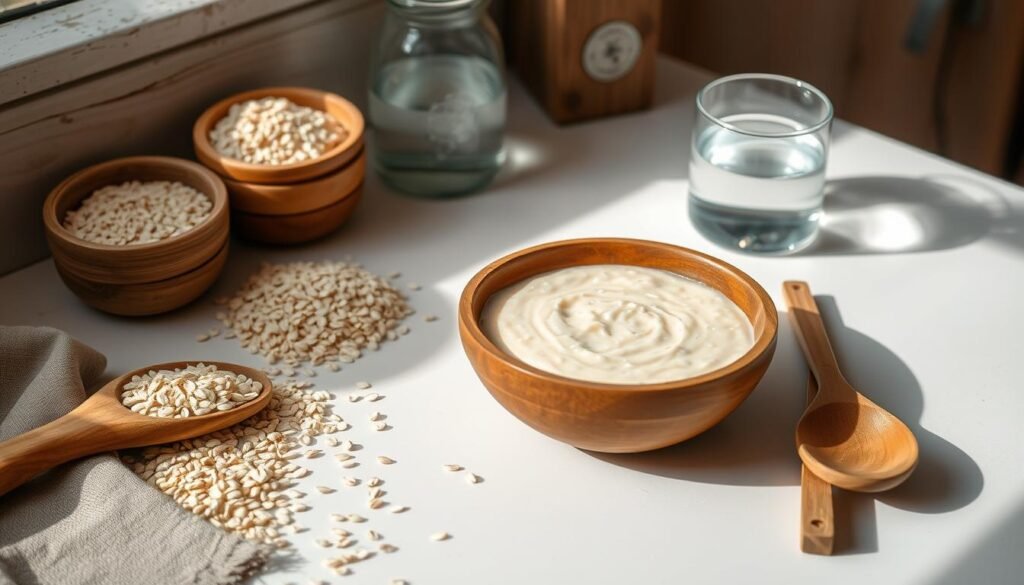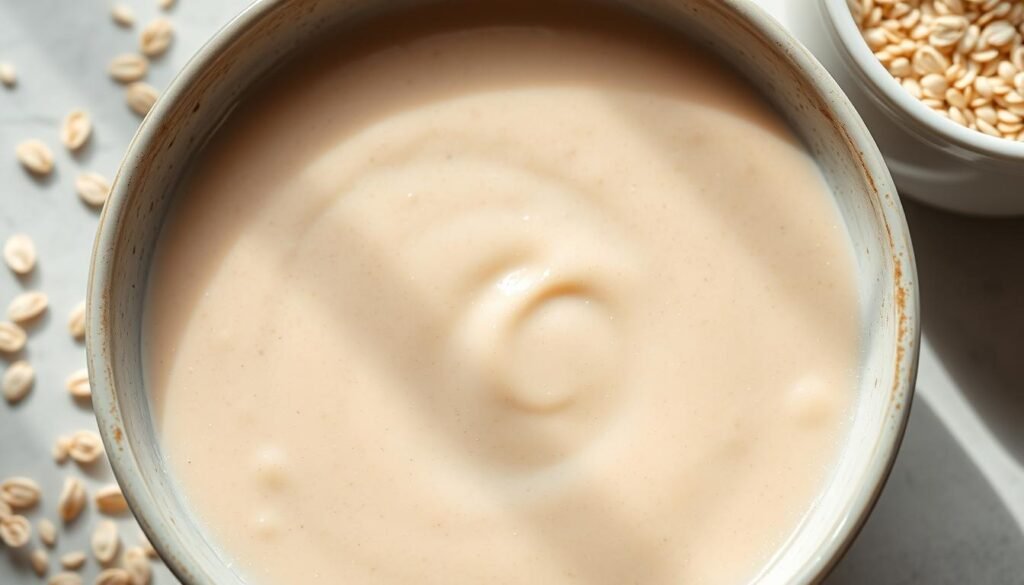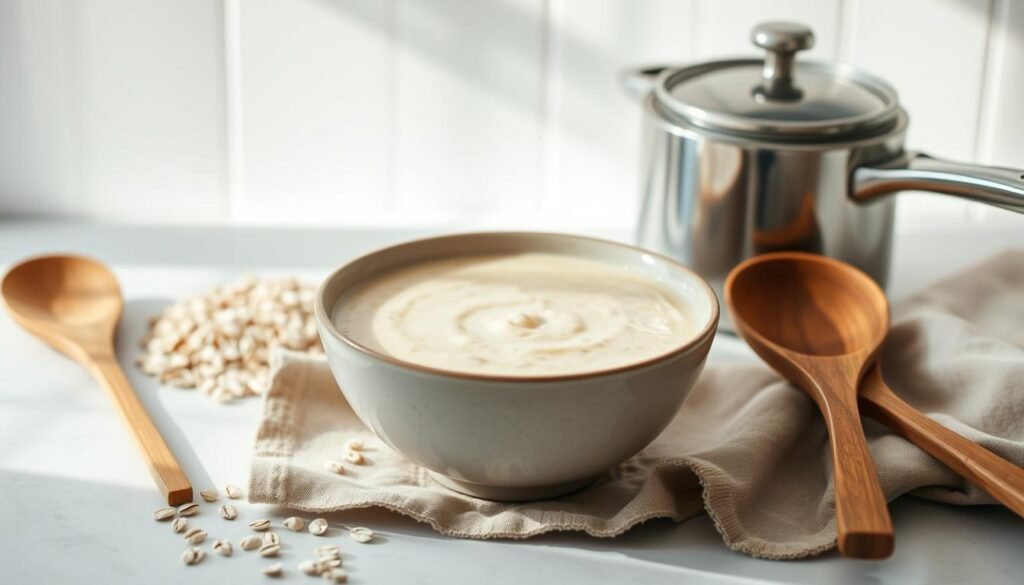Surprisingly, gruel, the bland porridge of 19th-century Britain, might have tasted better than expected1. It was a key food for peasants and the sick1. Even the Titanic served it in 19121. So, what did this simple dish taste like?
Key Takeaways
- Gruel was a thinner version of porridge that was more often drunk rather than eaten1.
- Gruel was a common staple food for the poor, especially in workhouses, as depicted in Charles Dickens’ novels1.
- Gruel’s taste and texture were influenced by the use of ingredients like barley, wine, lemon zest, and sugar2.
- The recipe for 18th-century barley gruel suggests a custard-like thickness and a flavor profile that includes sweetness, acidity, and a tapioca-like texture2.
- Gruel continues to be referenced in popular culture today to represent poverty and deprivation1.
Exploring gruel’s history helps us understand its taste and role in Victorian-era Britain. Understanding the taste of gruel is key to appreciating the lives of those who relied on it.
Gruel: The Porridge of Poverty
Gruel has been a food for the poor for centuries, starting in ancient Greece and Rome. In the Middle Ages, peasants made gruel by grinding grains and simmering them in water or milk.3 It was also a staple for workhouse inmates during the Industrial Revolution in Britain. Charles Dickens wrote about it in his novels.
A Historical Perspective
In “Oliver Twist,” Charles Dickens showed how poor orphans ate thin gruel three times a day. They also got an onion twice a week and half a roll on Sundays3. The workhouse diet mainly included this porridge, sometimes with onions or milk for extra nutrition3. Charles Elmé Francatelli, Queen Victoria’s chef, wrote about different gruel recipes in “A Plain Cookery Book for the Working Classes” (1852). He included recipes for oatmeal, pearl barley, and rice gruel, even for the sick.3
The Workhouse Diet
Interestingly, barley gruel cooked in wine with sugar was seen as a strong medicine, not just for the poor like in “Oliver Twist.”3 Meat was expensive in Victorian times, making it a luxury for the rich. This contrasts with the simple gruel given to the poor3. Historic recipes show many ways to make gruel, proving it was a versatile dish.3

“Gruel was a key component of the poor orphans’ diet in Charles Dickens’ novel “Oliver Twist,” with three meals of thin gruel a day being provided, along with an onion twice a week and half a roll on Sundays.”3
What did gruel taste like?
Charles Dickens’ vivid descriptions of gruel in “Oliver Twist” give us a glimpse into its taste and texture. He described it as a watery, bland porridge, often served in small portions to the poor4. Yet, some modern recipes suggest it might have been smoother and tastier than Dickens made it out to be5.
Analyzing Dickens’ Descriptions
In “Oliver Twist,” Dickens called gruel “thin and watery,” lacking in both taste and substance4. The gruel in workhouses was a meager meal, leaving residents, like Oliver, hungry for more. Dickens’ vivid descriptions show the harsh life in Victorian workhouses and the poverty faced by many4.
“Please, sir, I want some more,” Oliver said quietly, looking up at the master. The master turned very pale, and gazed in stupefied astonishment on the small rebel for some seconds, and then clung for support to the table; the assistants were paralysed with wonder; the boys with fear.
This famous passage from “Oliver Twist” highlights the stark contrast between the small gruel portions and Oliver’s growing hunger. It reflects the harsh realities of life for the working poor in Victorian England4.

While Dickens painted a bleak picture of gruel, some modern interpretations suggest it might have been tastier5. By studying Victorian-era gruel recipes, researchers found it could have been smooth and had subtle flavors when made right54.
The Surprising Taste of Gruel
Modern versions of Victorian-era gruel recipes have a surprisingly good taste6. Charles Dickens might have made gruel sound bad, but a recipe from 1838 shows it’s just oats, milk, and water. These ingredients make a smooth, mild porridge.
Studies by the Royal Society of Chemistry found gruel tastes good when made right6. This shows gruel wasn’t always bad-tasting. It reminds us that how we see old dishes can be shaped by stories and biases.
Recreating the Victorian Recipe
To get the real taste of gruel, we need to go back to its origins7. For thousands of years, people have loved hot, cooked mush. The Victorian gruel recipe gives us a peek into the past.
By following old recipes and using the right ingredients, we can make 19th-century gruel6. This lets us explore history and understand a dish once seen as poor.

If you love history or just want to try something new, gruel might surprise you6. It lets us see how our food traditions have changed. It shows how our views of the past can shape our taste buds67.
Gruel: Nutritional Value and Health Benefits
Gruel was a vital food, especially for the poor. It was made from rice, oats, or wheat. These ingredients gave gruel important nutrients like carbohydrates, fiber, and vitamins8.
In the past, gruel was given to the sick. It was easy to digest. Oats, used in gruel, have been valued for their health since the 1500s9.
But, eating only gruel was not enough. It lacked some key nutrients. For example, payar, a dish made with green gram, is rich in protein and energy10.
Kanji, a rice porridge, is full of fiber, minerals, and antioxidants. It’s good for the heart and aids in weight loss10. Mung beans in payar help with weight loss and fight cancer10.
Kanji and Payar together are great for digestion. They are also filling, helping with weight loss10. Without ghee, this dish is vegan-friendly10. Mung beans are also gluten-free, good for those with gluten issues10.
In summary, gruel was more than just a simple dish. It was packed with nutrients. Traditional gruel dishes, made with whole grains, legumes, and vegetables, are still nutritious today. They are a valuable part of our culinary history.
Variations of Gruel Around the World
Gruel is not just a food from Victorian-era poverty. It’s a nourishing porridge found in many cultures worldwide11. From Asia’s savory rice porridges to Central America’s maize gruels, these dishes are humble and sustaining12.
From Congee to Atole
In Asia, dishes like congee in China, okayu in Japan, and juk in Korea are similar to European gruel11. These rice porridges, topped with various ingredients, offer a comforting texture12. In Central America, atole is a thick, nourishing maize gruel11.
Though ingredients and flavors vary, these porridges share a common tradition. They use simple, affordable ingredients to create a filling food12. These dishes offer a taste of history and a comforting link to cultural heritage11.
“Gruel has been a basic and often economical food throughout history, often associated with simple, easily digestible nourishment.”12
The Origins and Etymology of Gruel
The word “gruel” comes from Middle English “gruel,” which is linked to Old French “gruel.” It goes back even further to Late Latin13. This shows gruel’s simple start as a food made from ground grains. The term has spread across Europe, showing gruel’s wide use in history13.
Gruel first appeared in the 12th century as a fine flour from lentils or beans13. By the 14th century, it was a liquid food made from oatmeal, boiled in water or milk13. Recipes added meat, onions, spices, sugar, or almonds, showing its flexibility13.
Gruel’s history is tied to porridge, another ancient food. In the 18th century, ‘burgoo’ was oatmeal porridge for British sailors14. Sailor William Spavens wrote about making ‘burgoo’ with 3 parts oatmeal to 1 part water, a practical meal at sea14.
The stories of gruel and porridge show the rich history of these foods13. Exploring gruel’s origins reveals a tale of culinary trends and the love for simple, nourishing meals.
| Dish | Historical Progression | Key Ingredients |
|---|---|---|
| Gruel |
|
|
| Porridge (Burgoo) |
|
|
The history of gruel and its link to porridge like burgoo show their lasting appeal. From simple beginnings to today, their story is a culinary adventure worth exploring.
Gruel in Popular Culture and Fiction
Gruel is deeply rooted in popular culture, especially tied to poverty in Charles Dickens’ novels15. The scene in Oliver Twist where Oliver asks for “more” gruel is famous15. It shows gruel as a sign of poverty and hardship15.
In A Christmas Carol, Ebenezer Scrooge’s gruel is another example of gruel’s bad image15. These stories have made gruel seem unappealing and low-quality to many.
Oliver Twist and Other Literary References
In Oliver Twist, Dickens contrasts fictional diets with real workhouse food15. Recipes for the sick were common until the 20th century16. Gruel, a thin porridge, was given to those recovering16.
But, gruel’s image in literature often hides its real nutritional value15. It was a food for the poor and sick15. Works like Oliver Twist have made gruel a symbol of poverty15.
Literature has shaped our view of gruel’s history15. Exploring gruel’s true story shows it’s more than just a simple porridge1516.
Modern Interpretations of Gruel
In recent years, gruel has seen a comeback. Chefs and food historians are now making historical gruel recipes again. They find that with care, gruel can be quite tasty17.
These modern takes on gruel focus on its health benefits. They show how gruel was a staple for the poor and working classes18. By updating old recipes, they aim to change its image in popular culture.
Modern gruel recipes use whole grains like oat groats and chia seeds. This makes a filling, slow-cooked porridge. You can top it with berries or nuts for a tasty breakfast or snack17.
By updating gruel recipes, we see its nutritional and culinary value18. As people look for affordable, sustainable food, gruel offers a unique experience. It’s a dish with a rich history and modern appeal.
| Gruel Recipes | Historical Dish Reinterpretations |
|---|---|
| Oat Groats Gruel with Chia Seeds and Flax | Snail Water from 1700 |
| Slow-Cooked Whole-Grain Porridge | Fricasie a Chicken or Rabbit from 1655 |
| Customizable Gruel Toppings | Brassica Oleracea Dishes (Broccoli, Brussels Sprouts, Cauliflower) |
“By embracing the versatility of gruel and updating traditional recipes, these efforts aim to move beyond the negative associations that have long been perpetuated in literature and popular culture.”
The culinary world is always changing. Rediscovering gruel lets us connect with our past. It also opens up new ways to enjoy healthy food1718.
Gruel: A Taste of History
Exploring gruel gives us a peek into the lives of the working class in 19th century Britain. Charles Dickens made gruel seem like a poor, meager food. But, the truth might have been more complex. Learning about gruel’s history, how it was made, and its different meanings helps us see its value as a food for the poor and underprivileged.
Unlike what literature shows, gruel was often mixed with rum, wine, port, fruits, honey, and nuts. This shows that gruel recipes in the Georgian era were varied19. Also, gruel was both sweet and savory and eaten by all classes before Dickens made it seem like a thin, greyish blob for orphans19.
People are still interested in making historical foods, like gruel. When a program called “What the Lesser Sort Ate” served barley and raisin gruel, many guests asked for the recipe19. A recipe from 1724, by John Knots, gives us a closer look at how gruel was made back then19.
The traditional gruel recipe mixes a few tablespoons of cornmeal with water and boils it for 8-10 minutes20. The egg gruel recipe involves whisking four eggs until frothy and slowly adding them to boiling milk20. It’s suggested to drink half of the egg gruel while hot and the other half two hours later for health benefits20.
Making gruel is quick and simple, making it great for those who are sick20. The author advises not to add white sugar to the egg gruel but notes that it can make a delicious custard dessert with fruit20.
Gruel’s transformation from a simple food to a symbol of poverty in popular culture is fascinating. By exploring gruel’s history, we can discover its true diversity and importance. We can also appreciate the stories it tells through its simple, yet nourishing, ingredients1920.
“Gruel, though often portrayed as a wretched fare, was in reality a versatile and important part of the historical diet, nourishing generations of the underprivileged.”
| Ingredient | Quantity |
|---|---|
| Pearl-Barley | Specific measurements |
| Currants | Specific measurements |
| Eggs | Specific measurements |
| White Wine | Specific measurements |
| Cream | Specific measurements |
| Lemon Peel | Specific measurements |
| Sugar | Specific measurements |
Conclusion
Exploring gruel’s history and variations has deepened my respect for this simple yet vital dish. Gruel’s taste, once seen as unappealing, was actually enhanced by ingredients like meat and spices21.
Gruel’s journey from a peasant food to a global staple is fascinating. It was a key meal in many cultures, including Mesoamerica and British hospitals1. Millet, a common gruel ingredient, was rich in nutrients, helping those who relied on it.
Learning about gruel and similar dishes helps us understand the lives of those who had little. By exploring these foods, we see the struggles and strength of past generations. This appreciation enriches our understanding of our shared culinary history.
FAQ
What did gruel taste like?
Charles Dickens described gruel in Oliver Twist as watery and bland. Yet, modern Victorian gruel recipes suggest it might have been creamy and flavorful.
How was gruel prepared historically?
Peasants in the Middle Ages ground grains at home. They simmered them in water or milk to make gruel. In Britain’s Industrial Revolution, gruel was a staple for workhouse inmates.
What was the nutritional value of gruel?
Gruel from oats, wheat, or other grains is rich in carbs, fiber, and vitamins. It was a vital food for the poor, offering important nutrients.
Are there variations of gruel-like dishes around the world?
Yes, many cultures have their own versions of gruel. In Asia, dishes like congee in China and juk in Korea are similar. In Central America, atole, made from maize, is a common gruel.
How has gruel been portrayed in popular culture and literature?
Gruel is deeply linked to poverty in Charles Dickens’ works. The scene in Oliver Twist where Oliver asks for more gruel has made it a symbol of hardship.
What efforts have been made to reexamine and reinterpret gruel?
Lately, there’s been a push to relook at gruel. Chefs and historians are making historical gruel recipes. They find it can be tasty when made with care.
Source Links
- https://en.wikipedia.org/wiki/Gruel – Gruel
- https://savoringthepast.net/2016/08/01/barley-gruel/ – Barley Gruel
- https://nicoandamysliterarykitchen.wordpress.com/2017/01/30/frugal-january-victorian-gruel-from-oliver-twist-1837/ – Frugal January: Victorian Gruel from Oliver Twist (1837)
- https://sites.psu.edu/epop/2020/04/18/a-grueling-experience-oatmeal-gruel-victorian-era/ – A Grueling Endeavor (Oatmeal Gruel, Victorian Era)
- https://www.historyquester.com/gruel-and-more-gruel/ – Gruel and More Gruel
- https://www.theguardian.com/lifeandstyle/australia-food-blog/2015/jan/07/gruel-with-a-twist-can-food-trends-get-any-weirder – Gruel with a twist: can food trends get any weirder?
- https://www.mentalfloss.com/article/70649/boiled-down-history-porridge-and-gruel-7-facts – A Boiled-Down History of Porridge and Gruel in 7 Facts
- https://www.charlottenewsvt.org/2019/01/23/morning-gruel/ – Morning gruel – The Charlotte News
- https://giveitforth.blogspot.com/2017/01/harleian-ms-279-ab-1430-xxiiij-drawyn.html – Harleian MS. 279 (ab 1430) – .xxiiij. Drawyn grwel – Tempered Gruel
- https://chandrasekharsurekha.medium.com/kanji-rice-gruel-62a3de5a93d9 – Health Benefits of Kanji, Rice Gruel and Mung Beans
- https://en.wikipedia.org/wiki/List_of_porridges – List of porridges
- https://veggiedesserts.com/gruel/ – Gruel
- https://bricabrac164.blog/2020/05/17/pudding-or-gruel-you-decide/ – Pudding or Gruel? You decide.
- https://carlyjbrown.com/2020/10/12/madeira-mondays-making-an-18th-century-sailors-breakfast/ – Madeira Mondays: Making an 18th century sailor’s breakfast
- https://www.irishtimes.com/culture/books/cowpie-gruel-and-midnight-feasts-food-in-popular-children-s-literature-1.2885193 – Cowpie, gruel and midnight feasts: food in popular children’s literature
- https://rhubarbsago.com/2017/06/11/peptonized-gruel/ – Peptonized gruel
- https://recipes.hypotheses.org/10324 – What did early modern food taste like?
- https://www.independent.co.uk/life-style/food-and-drink/news/gruel-all-round-as-the-victorian-workhouse-diet-makes-a-comeback-937003.html – Gruel all round as the Victorian workhouse diet makes a comeback
- https://jasna.org/about/jasna-post/gruel/ – “A Nice Basin of Gruel Together” Indeed » JASNA
- https://www.historyquester.com/tag/egg-gruel/ – egg gruel – History Quester
- https://www.ncbi.nlm.nih.gov/pmc/articles/PMC7684608/ – Determination of fungal diversity of acidic gruel by using culture‐dependent and independent methods

